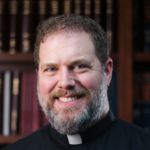
The healing of the man born blind happens in the midst of the Feast of Tabernacles (sometimes the Feast of Booths, or Sukkot). There’s reason for John’s lengthy account—more, that is, than an apostolic sense of humor over the ridiculous back-and-forth including the man, the Jewish authorities, his parents, and the neighbors. The persistent unbelief and blindness on display here stand as signs of ongoing unbelief and blindness in the face of God’s work in Jesus Christ. The world will always find reasons to dislike and dismiss this simple faith, echoed in many a convert: “One thing I know, that though I was blind, now I see (John 9:25).
The larger context of this story, especially in the midst of the feast, suggests that the early Church, and at the very least those associated with St. John the Evangelist, saw in this story a kind of illumination of baptism. As St. Augustine points out, the man is first “anointed” before he regains his sight. Notice the connection there between the anointing in 1 Samuel of King David—another figure who is at first misjudged by his appearance. It’s a strange anointing, to be sure, but at least some Jews in the first century (as evidenced by the Dead Sea Scrolls) envisioned the creation of Adam in Genesis 1 as being not merely from earth or dust, but also from a kind of mud formed with divine spit. Whether they believed this literally or not, the symbolism is clear: by sharing of his own nature, Jesus begins the re-creation of this man, the restoration of the divine image.
After this anointing, the man is sent to the Pool of Siloam to wash. For Augustine, the similarity to the sacraments is quite clear: “If, therefore, when he baptized him in a manner in himself, he then enlightened him; when he anointed him, perhaps he made him a catechumen.” Most people don’t see baptisms often, so you might forget a small ritual moment that remains with us today, having its origins in the apostolic Church: the anointing of the candidates with the oil of catechumens as a preparation for baptism.
But there’s more. The Pool of Siloam is the gathered waters of the spring of Gihon. That spring, one of the more important water sources for Jerusalem, was named after one of the four rivers flowing out of Eden in Genesis. It suggests the ways that ancient Israel saw the holy city as a restoration, at least in part, of lost Paradise. On the final day of the Feast of Tabernacles, water from Siloam was drawn and carried to the Temple, where it was ceremonially poured on the altar. This was, at the same time, a ritual prayer for rain, a thanksgiving for water—especially the numerous provisions of water during Israel’s wanderings in the wilderness—and a kind of foretaste and glimpse of the apocalyptic visions of the prophets, most famously of Ezekiel, where water flows from the temple to renew the face of the whole earth. For the Church, those visions have long been read as types and shadows of baptism. Recall that the whole meaning and purpose of Lent, historically, is a preparation for Easter, which, in addition to the great celebration of Christ’s resurrection, is the normative moment for holy baptism, which is itself our incorporation into Christ’s death and resurrection.
The Ambrosian rite, in fact, has a unique preface used on this Sunday: “By thee,” it reads, “when the world’s blindness was taken away, the true Light shone out upon the weak, since among the miracles of thy many powers, thou didst command a man, blind from birth, to see: in whom the human race, stained with original blindness of the mind, was typified. . . . For by that bathing-pool of Siloam, to which that blind man was sent, is signified none other than the sacred Font, where not merely bodily eyes but the whole man is made whole.”
This season makes much of light and darkness, sight and blindness. Starting next week, during what’s known as Passiontide, the images and crosses in many churches—and maybe even in many homes and other places where the faithful pray—will be veiled from our sight. They will remain veiled until the great unveiling of the crucified on Good Friday, when Holy Church calls out for us to behold the wood of the cross whereon was hung the world’s salvation. Then out the darkness of that night, and the grey twilight of Holy Saturday, new light springs out of the darkness of the great night of nights, when hell is conquered, and man is reconciled to God.
There are of course many people in this season preparing for baptism. In all of these images, from Scripture and Tradition, we call to mind their holy preparation and remember them in prayer. But we who are already baptized, who have received the light of faith, must recall first that we were all once the blind man, lost in a world of darkness. Lent should be a preparation, if not for baptism, at least for the renewal of the promises of baptism: to reject again the false vocations of the world, the flesh, and the devil, and to turn again and receive again our re-created nature in Christ.
Approaching the Lord in baptism—and indeed approaching him in any need —requires an act of humility. The Pharisees at the end of this story are a sign of warning. They ask, after rejecting the blind man’s testimony, “Are we also blind?” The statement drips with sarcasm from those confident in their own holiness. And Jesus answers, “If you were blind, you would have no guilt; but now that you say, ‘We see,’ your sin remains” (John 9:41).
There’s a good reason why Catholic liturgy spends a lot of time on penitence. Even in the midst of Easter, we’ll go to confession, we’ll do the penitential rite at Mass, we’ll sing the Kyrie. The fact that God has saved us doesn’t mean we don’t still need saving day after day. And again I think this ties in closely with the purposes of Lent: we remember being blind. Like the people of Israel commemorating the Exodus, remember that we were slaves. Indeed, we find in ourselves the constant clinging chains and shadows of sin.
The authentic proclamation of the Christian message is not merely a positive thing in which Jesus goes around telling everyone how great they are. It is movement from darkness to light, from sickness to health. And what we see in today’s Gospel is a reminder of how important it is to tell that whole truth. As the man born blind tells the skeptics, “one thing I know, that though I was blind, now I see” (John 9:25).



